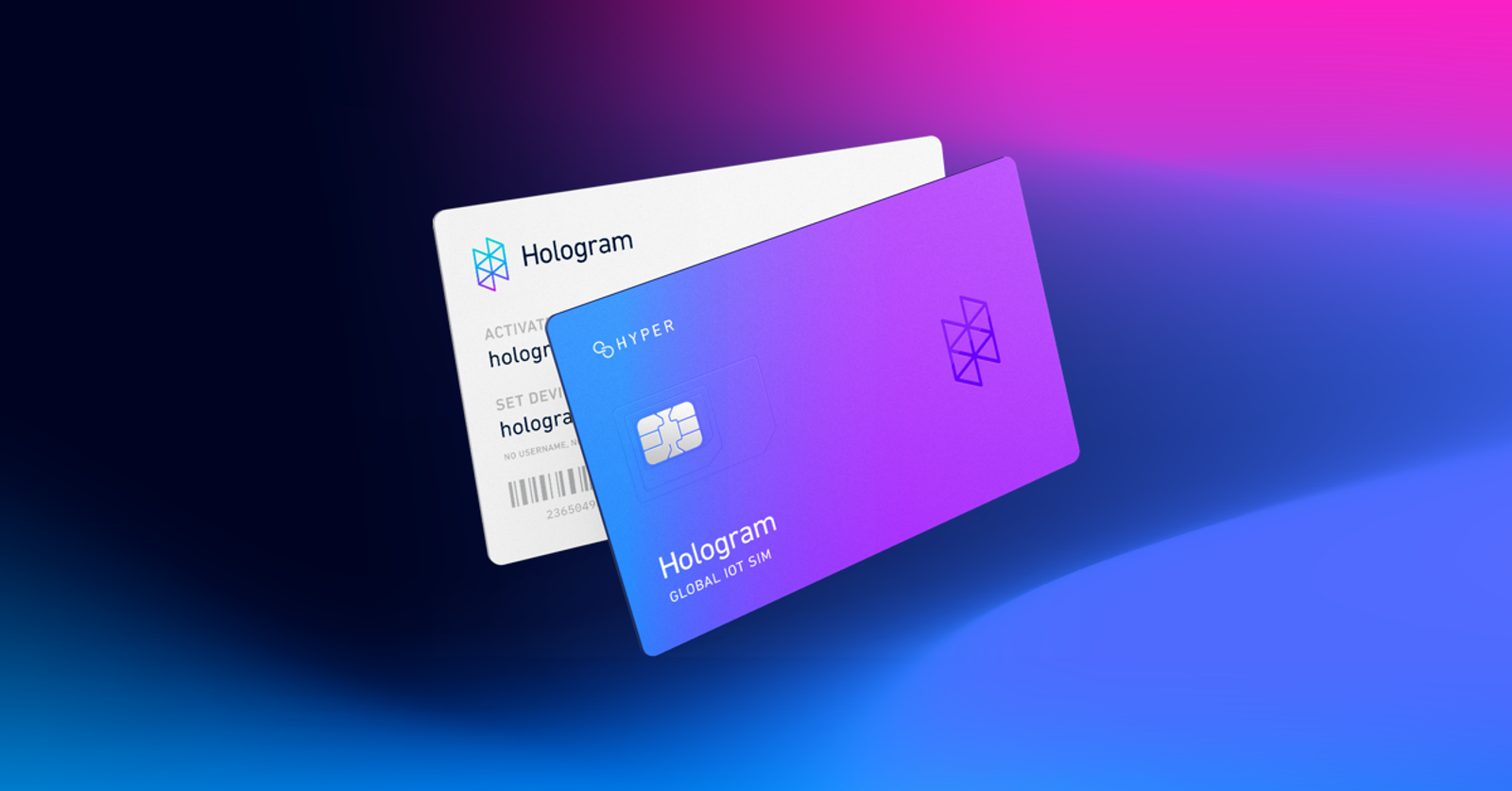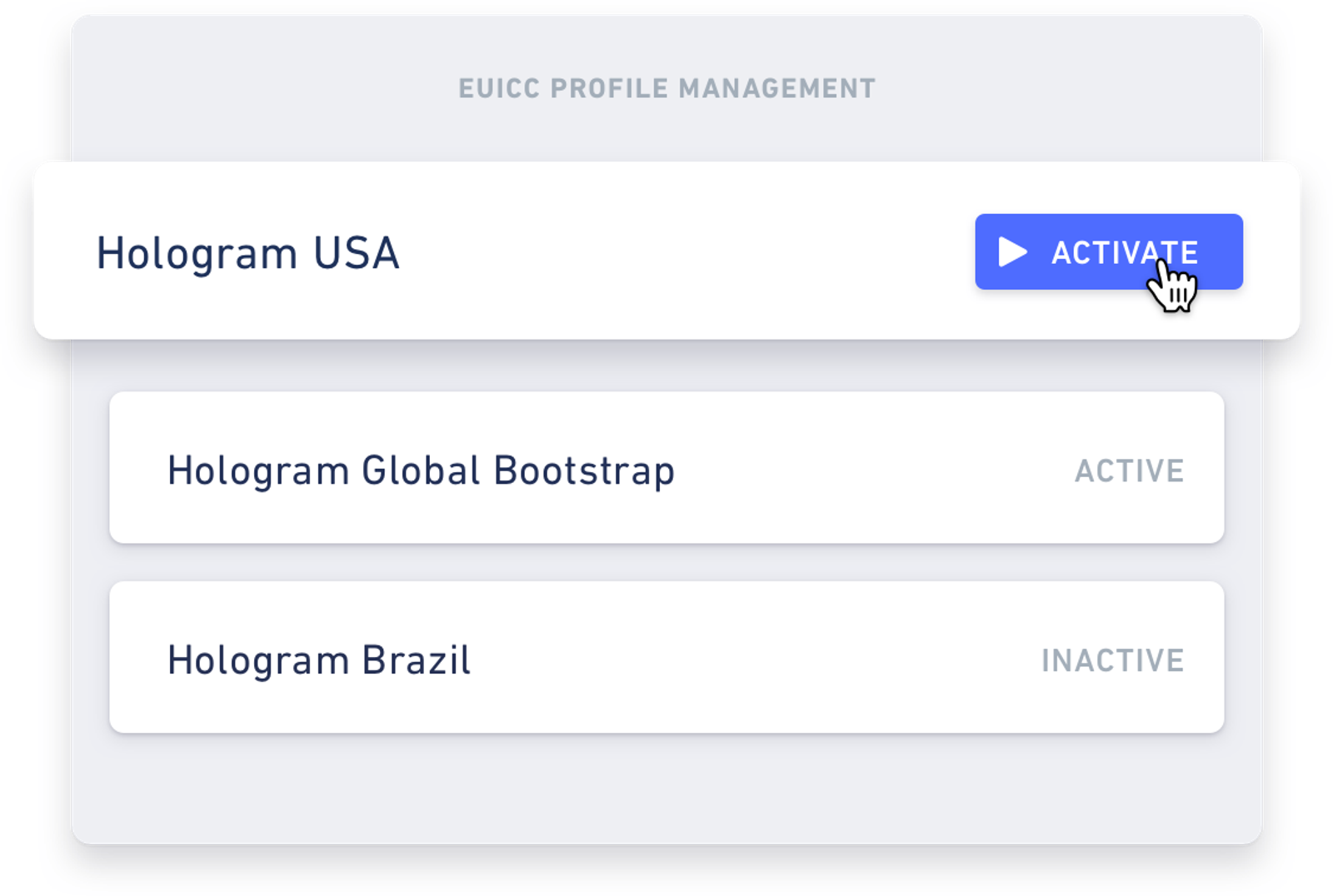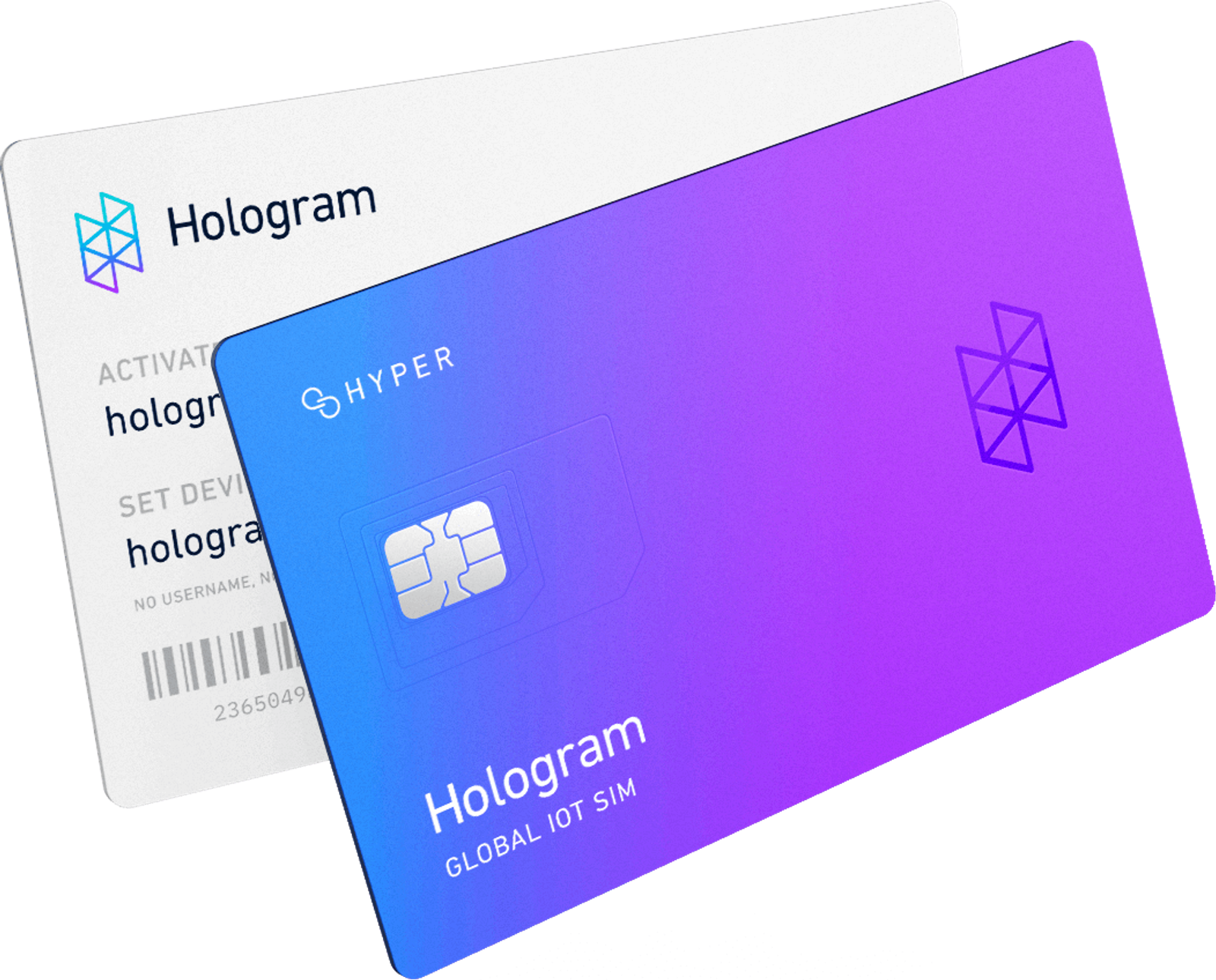Unlock a New Level of Cellular IoT Connectivity With Hologram Hyper, our new eUICC SIMs and Platform

Hyper helps organizations scale faster by providing over-the-air, updatable access to Hologram's full portfolio of connectivity partners.
Starting today, Hologram customers can unlock a new level of cellular IoT connectivity with Hologram Hyper, our eUICC SIMs and platform. Hyper helps organizations scale faster across different markets by providing over-the-air, updatable access to Hologram's full portfolio of cellular IoT connectivity partners and profiles. It’s the key to flexibility for your IoT project—in coverage, performance, and pricing.
“Software is eating the world,” says Hologram founder and CEO Ben Forgan. “With IoT, software is also ‘eating’ the physical world, creating opportunities for companies to build exciting products and generate efficiencies through automation. Hologram is doing our part with Hyper, our eUICC platform, by turning connectivity into software.”
Cellular IoT Implementation Challenges
With markets changing faster than ever, global IoT organizations must be able to scale quickly while staying connected in a telecom world that’s constantly evolving. Here are a few of the challenges IoT developers face today:
Managing Diverse Use Cases with a Unified Platform
In the world of IoT, anything can be connected—which means there’s a wide spectrum of use cases and corresponding data and platform needs. An IoT temperature sensor only needs to transfer a small amount of data each day, requiring minimal data traffic in bytes, while a 24/7 security video camera needs a constant connection and transfers much higher data amounts in the gigabyte range.
The Need for Global Coverage
Many enterprises are exploring large-scale, global IoT deployments. Smaller businesses also want to expand their reach around the globe, but achieving a worldwide deployment with traditional SIM cards requires logistical acrobatics. IoT organizations are on the lookout for solutions that can simplify the launch process and enable global reach without complicating the supply chain.
Complex Access Technologies
Gone are the days of global quad-band 3G standards across 850/900/1800/1900MHz. Fragmentation across LP-WAN cellular IoT technology means LTE connectivity is far more complex than its predecessor—and NB-IoT, LTE-M, and 5G bring their own complications. For example, today’s devices must support more than 10 LTE bands to function in the European Union.
Evolving Regulatory Standards
IoT teams must align their devices with regulatory standards and seek required certifications from a country’s governing bodies (the FCC and PTCRB in the U.S.). As projects expand around the globe, devices and their communications hardware must align with local telecommunications policies in every region they wish to deploy—and in some places, those standards are shifting. For example, Brazil recently passed a telecoms modernization bill with major changes to the regulatory framework and requirements. And a recent decision in Turkey prohibits data roaming for imported eSIM device.
The Complexity of Global Scalability
Designing and manufacturing IoT hardware equipped to connect in many regions around the world requires complex coordination across carriers, technical integrations, and supply chains. When you’re scaling the project to 10 countries and need 10 different product variations to enable those devices to work once they’re on the ground, the process can become complicated and expensive.
In addition to supply chain problems, swapping out SIMs requires another operations process that can inhibit growth in new markets.
What if you could manufacture a single device with one SIM card or eSIM that can adapt to any use case and region in the world? That’s the promise of eUICC—and it’s here.
eUICC for Consumer vs. M2M/IoT Devices
eUICC has seen some traction in consumer settings (Google Pixel and Apple iPhone, for example), but thus far, adoption for M2M/IoT has been slower. eUICC for IoT is really a different animal because there’s no human interaction on the device end. To offset that lack of oversight, IoT devices need extra-resilient architecture and additional capabilities, so GSMA created implementation standards and fail-safes specifically for M2M/IoT eUICC.
There’s not likely to be a person holding an IoT device while it’s communicating from the field, so eUICC software functions differently in IoT applications than it does in consumer devices. It’s equipped with a fall-back mechanism, allowing the device to reconnect automatically if the provisioned network profile loses its connection.
And because IoT devices are often used to transmit critically important data, GSMA includes additional security standards.
Because of the added complications and security concerns, eUICC for IoT was only feasible for very large enterprises (such as automotive fleets).
Until now, the eUICC ecosystem lacked the platform providers and turnkey solutions most IoT designers are seeking. . Operating an eUICC solution requires access to the eUICC SIM hardware, an eUICC operating system (which lives on the SIM itself to enable profiles), an eUICC platform (remote server provisioning or RSP), and carrier integrations or other agreements that are eUICC-capable. That’s a difficult puzzle to assemble on your own—but with Hyper, it’s already done.

Make Your Connectivity Future-Proof
Building on our existing network partners and integrations, world-class IoT dashboard, and open API capabilities, Hyper streamlines cellular IoT for Hologram’s customers and expands our capability to provide flexible coverage.
Hologram Hyper’s features include:
Single, Global IoT eUICC-ready SIM SKU
Future-proof your hardware with an eUICC-capable SIM that can be updated remotely through Hologram's eUICC platform. Our eUICC is available in both triple-cut cards and MFF2 embedded (eSIM) form factors, and existing customers can transition their fleet without a new board design or hardware manufacturing process.
Access to Hologram's Global Network of Carrier Partners and Profiles
Launch your fleet with Hologram, an established IoT connectivity partner with an always-expanding portfolio of global and localized connectivity coverage profiles. With us, you won’t need to change hardware or SIM SKUs.
Unified, Collaborative Platform
Manage your fleet through Hologram’s collaborative IoT connectivity platform for fast-growing teams.

Why Transition to eUICC?
Streamline your operations with a single SKU across your fleet. Through eUICC over-the-air updates, just one SIM card or embedded chip provides the flexibility for evolving coverage options even after devices are deployed in the field.
Self-improving coverage and tailored pricing are made possible with eUICC. With its flexibility, we’re able to offer customized options to meet your business goals. And as we expand direct carrier relationships over time, our coverage only gets better.
Focus on your deployment, and we'll focus on providing the best connectivity. Avoid lengthy carrier negotiations and integrations. We've sorted it out and are constantly working to improve coverage options, performance, and flexibility for your organization.
Level Up to an eUICC-enabled Deployment
Talk to our sales team today about how your new or existing product can make the transition to an eUICC world and connectivity experience with Hologram Hyper. We’ll send you a Hologram Hyper-capable eUICC SIM so our team can test your hardware’s compatibility with our platform.
About Hologram
In 2013, Hologram began building the operating system for global connectivity, driven by a shared purpose: to connect everything to everyone, no matter the distance in between.
Thousands of teams rely on Hologram’s connectivity platform to keep their Internet of Things devices connected around the world. Spanning over 196 countries, 550 carriers, and the latest generation of spectrum technologies, Hologram makes launching and growing a fleet of devices incredibly easy.
Hologram has made it possible for the rapid growth of micromobility vehicles like e-scooters, and kept self-driving cars on the road. We’ve helped drones deliver medicine to remote communities, and kept vital health devices online across six continents.
The future will have billions more devices connected to the internet. Hologram is building the perfect network to help innovators connect the physical with the digital. Hologram brings the internet everywhere, for everything.